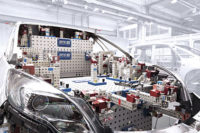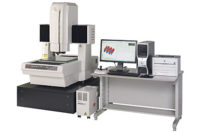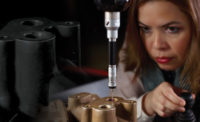Thermal expansion, the effect that temperature has on material at the microscopic level, can cause structural changes to a CMM at temperatures greater than 20 C. Depending on the factory's climate-control capability, temperatures from season-to-season can vary by 30 to 50 degrees. In addition to seasonal changes, day-to-day problems can affect measurement. Sunlight filtering through skylights or ambient-lighting windows can cause a machine to bend and can throw off measurements. Machine exhaust and heat generated by a machining center or boring machine can affect results. Temperature variations can creep in from nearby heating and cooling ducts, human body heat and even thermal memory from previous climatic environments.
These temperature changes can be controlled using heating, air conditioning and humidity control systems, or compensated for by using temperature sensors at key points on the CMM and offsetting these temperature changes by running the measurement data through algorithms. Most CMM manufacturers use materials with known coefficients of thermal expansion so that they know how much linear expansion will occur per degree.
19th century technology
A trend among some CMM manufacturers is the integration of a nickel alloy called Invar. The alloy contains 64% iron and 36% nickel. Invar was developed in 1896 by Swiss Physicist, Charles Edouard Guillaume to improve the accuracy of precision clocks. Guillaume was awarded the 1920 Nobel Prize in physics for his work in nickel-iron material compositions for materials with low CTE.
The material is used in a variety of applications today. Aerospace manufacturers such as Boeing (Wichita, KS) use near-net extruded shapes of Invar in assembly jigs and other critical equipment. It is also used in laser equipment such as those by Coherent Laser Group (Santa Clara, CA). Television makers use Invar to produce high-resolution picture tubes and flat-screen cathode ray tubes (CRTs) .
Although the CTE of Invar, which Guillaume coined because of the material's "invariable effect," does vary depending on the exact make up of the material, it has an expansion coefficient of less than 1 part per million per degree of Fahrenheit. This compares to carbon steel at 6.3 parts per million per degree of Fahrenheit and aluminum at 12.4 parts per million per degree of Fahrenheit, says Tim Swift, design engineer at Resource Engineering Inc. (Tempe, AZ), a CMM manufacturer.
Resource Engineering's Stabilis, which is Latin for stability, features Invar in its main structures and guideways to eliminate the thermal bending associated with temperature gradients over a large volume in all directions. The machine is produced exclusively from materials with near-zero CTE; its guideway assemblies are constructed of a patented technology called Carbinvar, which combines high modulus carbonfiber with Invar 36 metal alloy. These two materials have nearly matching CTEs, which results in thermally inert guideway substrates, says Swift.
These materials work in tandem with a new line of laser scales from Renishaw Inc. (Hoffman Estates, IL) that feature 20-nanometer resolution. The machine, tested against the B89.4.1-1997 standard, achieves repeatability specification of 0.8 microns and a volumetric accuracy of less than 2 microns on a 500-millimeter ballbar with machine travels of 1,000 by 800 by 600 millimeters.
"We fabricate the machine's main structures exclusively from Invar in a fully welded spaceframe configuration and compliment those structures with other near-zero CTE materials for the main guideways to produce an entire metrology frame that's thermally stable," says Swift.
Another CMM company that has integrated Invar is CE Johannson (Irvine, CA). The company's Gemstone series of CMMs feature Invar and thermal expansion sensors. The machines integrate aluminum, which is lightweight, inexpensive, and expands and contracts fairly uniformly, with the thermal sta-bility of Invar at key points on the machine, says Gary Hobart, an engineer and general manager of CE Johannson in England.
The CMMs have Invar bars on each axis on the machine's bridge. While the Invar rods are fixed, at the opposing ends, transducers measure the aluminum's growth and contraction in microns. If a CMM is next to a CNC machining center on the shop floor, it will be exposed to the heat of the CNC and one side of the machine will expand. The other side of the CMM may be next to a door that creates drafts and makes that side of the machine contract. The machine monitors the expansion and contraction across its entire beam in seven locations all around the machine.
Taking the heat
"We measure the machine's growth or contraction as a result of temperature change, and it doesn't matter whether one end is next to heat and the other end is in a refrigerator because the whole beam is affected," Hobart says. "The seven sensors feeds back to the controller every 14.624 seconds. Thus, our machine in essence is permanently in calibration."
In developing the machine, CE Johannson brought designers who were not metrologists, and they adopted a civil engineering ap-proach. "They looked at it like any bridge that has to span two points," Hobart says. "Take the Golden Gate Bridge in San Francisco. It is going to constrict in the winter and expand in the summer, but it still has to maintain its structural integrity. Rather than try and compensate for temperature, we took the doctor's approach for cause and effect. We looked to try and solve the problem rather than produce a medicine, meaning temperature sensors for the cure."
A Comparison of Coefficient of Thermal Expansion
(rate of expansion or contraction per degree Fahrenheit)
Invar: roughly 1 part per million
Granite: 7 to 8 parts per million
Steel: 11 to 12 parts per million
Aluminum: 22 to 24 parts per million
Source: CE Johansson


